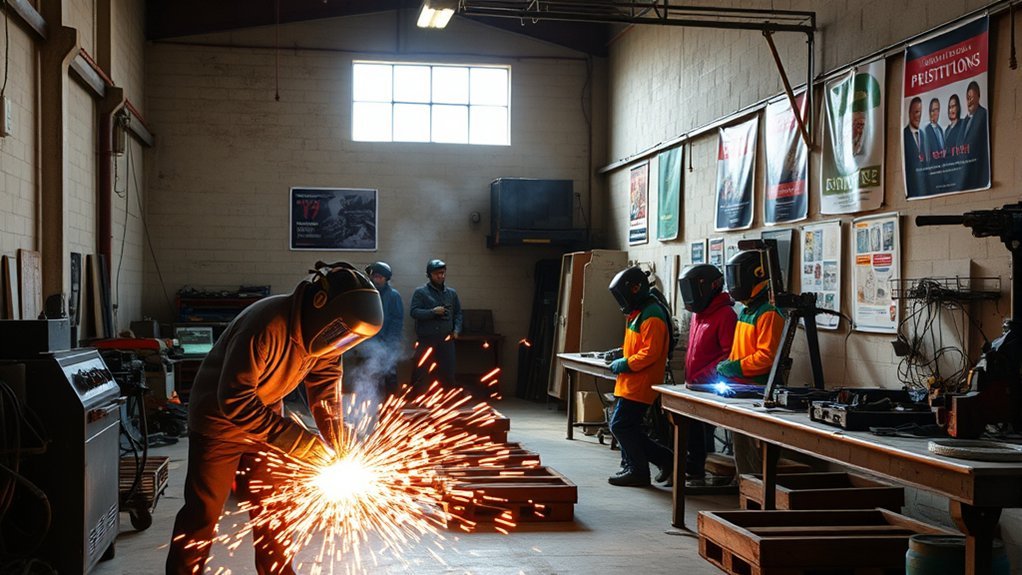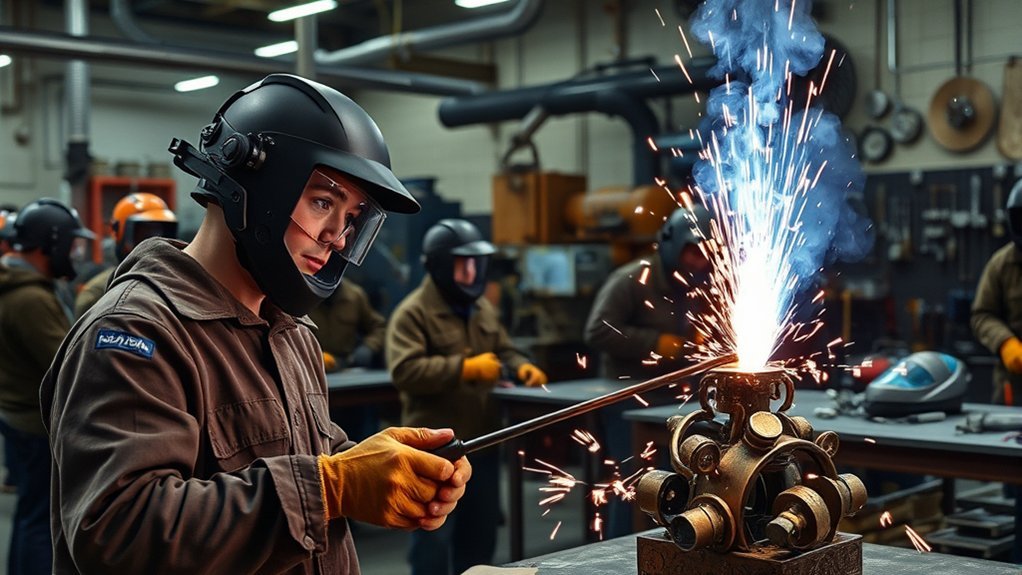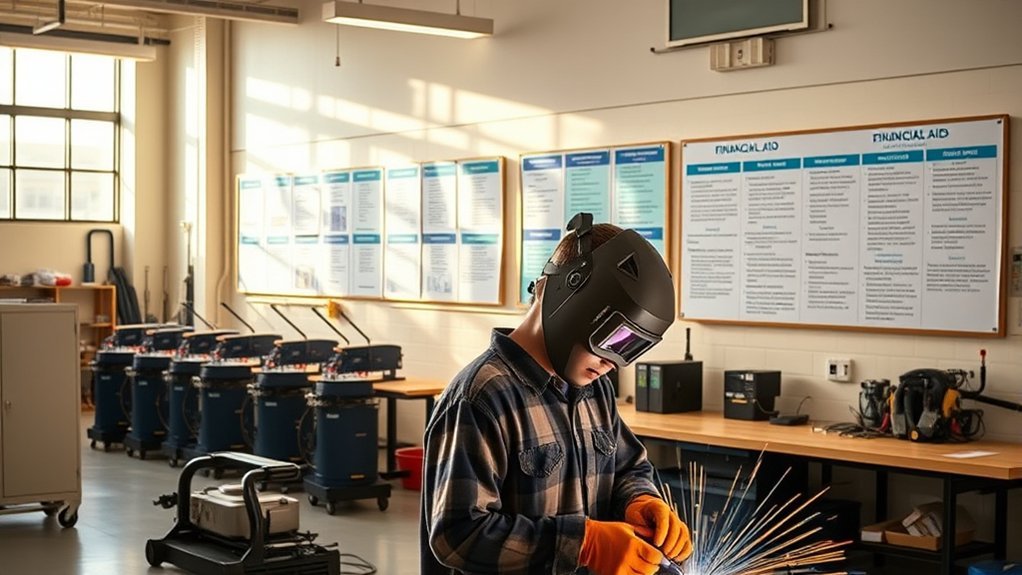Welding school costs can range from $5,000 to over $20,000, depending on the institution and program type. Community colleges typically offer two-year programs around $5,000, while trade schools may charge between $5,000 and $20,000 for hands-on training and certifications. Don’t forget additional expenses for equipment and materials, which can add up. The investment can lead to a lucrative career, so keep exploring your options to fully understand the financial landscape.
Understanding Welding School Costs

When considering welding school costs, you’ll find a range of options that can fit different budgets and needs. The average cost spans from $5,000 to $15,000, with some specialized programs exceeding $20,000.
Community colleges often provide more affordable two-year programs around $5,000, including general education classes. If you’re looking for quicker training, certificate programs can cost between $3,000 and $10,000 and last from a few weeks to months.
Remember to factor in additional expenses for equipment, materials, and safety gear, which can add another $100 to $2,500. Staying informed about current industry trends can help you choose the right welding techniques and education path, ensuring you get the best value for your investment.
Types of Welding Institutions

When you’re considering welding education, you’ll find various institutions to choose from, including trade schools and community colleges.
Trade schools focus on hands-on training and typically have tuition costs between $5,000 and $20,000.
On the other hand, community colleges offer more affordable programs, around $5,000 for two years, often incorporating general education alongside welding courses.
Trade Schools Overview
Trade schools play an essential role in vocational education, offering specialized programs focused on welding techniques. These institutions provide several trade school benefits for aspiring welders, making them a popular choice.
- Tuition typically ranges from $5,000 to $20,000, depending on the program length and type.
- Programs can last from a few months for certificates to two years for diplomas, catering to different skill levels.
- Many schools offer certifications upon graduation, enhancing your employability in the welding industry.
- Financial aid, scholarships, and grants are often available, ensuring accessible funding options.
With partnerships in local industries, trade schools also facilitate networking and job placement opportunities. This makes them an excellent choice for anyone looking to start a welding career.
Community Colleges Benefits
Although many think of trade schools for welding education, community colleges offer significant benefits that can enhance your learning experience. They typically provide affordable programs, averaging around $5,000 for a two-year course, making education accessible.
| Benefits | Details |
|---|---|
| Community Engagement | Strong local partnerships boost job placement opportunities. |
| Skill Enhancement | Combine vocational training with general education classes. |
| Flexible Scheduling | Options available for various commitments and lifestyles. |
With a range of programs from certificates to associate degrees, you can tailor your education to fit your career goals. Plus, financial aid opportunities often ease the burden, allowing you to focus on skill enhancement and community involvement.
Program Length and Structure

When considering welding programs, you’ll notice that their lengths can vary widely.
Certificate programs might only take a few weeks, while diploma programs usually require around a year to complete, and associate degrees typically span two years.
Understanding these timelines can help you choose the right path based on your career goals and commitment level.
Certificate Programs Duration
Welding certificate programs typically range from a few weeks to several months in duration, depending on the training provided. This flexibility allows you to choose a program that fits your schedule and career goals.
Here are some key aspects of certificate duration and structure:
- Hands-on training: Most programs emphasize practical welding techniques to prepare you for entry-level jobs.
- Classroom instruction: You’ll learn essential theories and safety protocols.
- Laboratory experiences: Gain real-world skills in a controlled environment.
- Certificate validation: Upon completion, you receive a certificate that enhances your employment prospects in the welding industry.
With such varied options, you can find a program that suits your needs while maximizing your learning experience.
Diploma Programs Overview
Many students find diploma programs in welding to be an excellent option for gaining the skills needed for a successful career. Typically lasting around one year, these programs cost between $5,000 to $15,000, depending on the school and location.
You’ll engage in a mix of hands-on training and theoretical coursework, focusing on essential welding techniques that prepare you for entry-level positions. Classes vary in size, impacting the amount of personalized instruction you receive.
Additionally, many programs offer general education courses alongside specialized welding training, providing a well-rounded education. Earning certifications during your diploma program can greatly enhance your job placement opportunities, giving you a competitive edge in the welding field and improving your employability.
Associate Degree Timeline
For those seeking a more in-depth education in welding, associate degree programs offer a detailed curriculum that typically spans two years. You’ll complete around 60 to 70 credit hours, combining general education with specialized welding courses.
Here are some curriculum details you can expect:
- Hands-on training, allowing you to practice welding techniques in real-world settings
- Courses covering safety standards and welding theory
- Opportunities to earn certifications from recognized organizations like the American Welding Society
- Career preparation for fields such as manufacturing, construction, and underwater welding
With this structured approach, you’ll gain not just technical skills but also a thorough understanding of the welding industry, enhancing your employability upon graduation.
Additional Costs to Consider

When planning your budget for a technical school in welding, it is crucial to take into account several additional costs beyond just tuition. Here’s a quick cost breakdown of potential hidden expenses you might encounter:
| Expense Type | Cost Range | Notes |
|---|---|---|
| Materials & Gear | $100 – $500 | Essential for hands-on training |
| Welding Machines | $500 – $2,000 | Varies by model and features |
| Books & Supplies | $100 – $500 | Necessary for coursework |
| Room & Board | $5,000 – $15,000 | Major factor if relocating |
These costs can add up quickly, so be sure to factor them into your overall budget to avoid any surprises during your journey into the welding profession.
Financial Aid and Funding Options

Reflecting on the various additional costs associated with technical school for welding, exploring financial aid and funding options becomes a smart move.
You can considerably reduce your education expenses by taking advantage of available resources. Here are some options to explore:
- Scholarship opportunities from professional associations and private companies, including those offered by the American Welding Society.
- Grants that don’t require repayment, helping to lower your tuition costs.
- Federal student loans with lower interest rates and flexible repayment options, making them an accessible choice for many students.
- Many technical schools, like MTI, participate in federal financial aid programs, providing various financing options.
Researching and applying for multiple financial aid opportunities can help you manage costs effectively.
Career Prospects After Welding School
As you complete welding school, you’ll find a wealth of career prospects awaiting you in various industries. The demand for skilled welders is on the rise, especially in construction and manufacturing, offering numerous job opportunities.
Graduates can expect a median annual wage of $47,540, but this can increase markedly in sectors like oil and gas, shipbuilding, and aerospace. Earning certifications, such as those from the American Welding Society, can enhance your employment prospects and may be necessary for specialized roles.
Many welding programs support your job search through networking and partnerships with local industries. Additionally, career advancement options in supervisory roles or specialized welding can lead to increased earning potential as your skills and experience grow.
Evaluating the Return on Investment
Evaluating the return on investment (ROI) for welding school reveals a promising financial outlook.
Evaluating the ROI for welding school shows a strong potential for financial success in your career.
When conducting a return analysis, consider the cost versus potential earnings. Here’s what you should know about your investment comparison:
- Cost of tuition: Ranges from $5,000 to $15,000, with community colleges often providing cheaper options.
- Average salary: Welders earn a median annual wage of $47,540, making this a lucrative career path.
- Job opportunities: High-paying positions exist in growing industries like oil and gas, shipbuilding, and aerospace.
- Financial aid: Scholarships and grants can greatly cut down expenses, boosting your ROI.
With entry-level wages starting at approximately $16 per hour, you can expect a quick financial payoff from your welding education.
Frequently Asked Questions
Are There Prerequisites for Enrolling in Welding Technical Schools?
Yes, you’ll typically need a high school diploma or GED. Some welding certifications may require specific admission requirements, like passing a physical exam or demonstrating basic math skills. Always check with your chosen school for details.
What Kind of Equipment Do Students Need to Purchase?
You’ll need essential welding tools like a helmet, gloves, and protective clothing, along with student supplies such as notebooks and pens. Investing in quality equipment enhances your safety and skills during your training.
Can I Attend Welding School Part-Time?
Absolutely, you can explore part-time options at many welding schools. With flexible schedules, you’ll find it easier to balance your commitments while gaining essential skills. Just check with the school for specific availability and requirements.
Is Online Welding Training Available?
Yes, online welding training is available. You can pursue online certification through virtual workshops, allowing you to learn essential skills from home while maintaining flexibility in your schedule. Explore various programs to find the right fit for you.
How Are Instructors Qualified in Welding Programs?
Like a blacksmith forging metal, instructors in welding programs hold relevant welding certifications and extensive industry experience. Their qualifications guarantee you receive practical knowledge, preparing you for the challenges and opportunities in the welding field.
Conclusion
In the world of welding, investing in your education can be like laying a strong foundation for a sturdy structure. While costs may vary, the potential rewards—both in skills and career opportunities—can outweigh your initial expenses. With financial aid options available, you can often lessen the burden. By weighing your choices carefully, you can forge a path to success that’s not only financially sound but also fulfilling. Your future in welding is bright—grab that torch and light it up!


